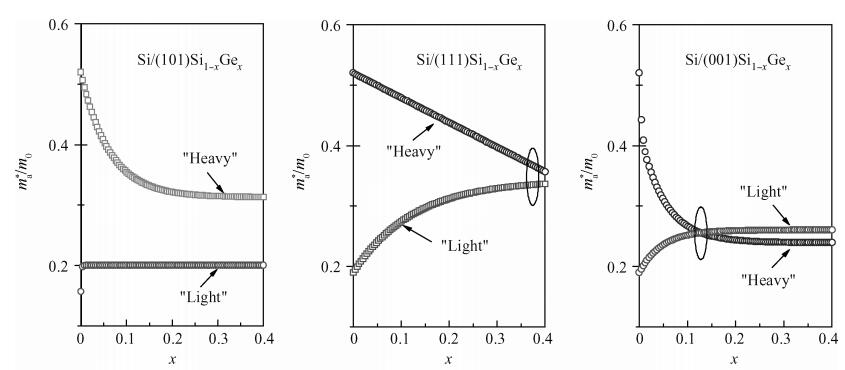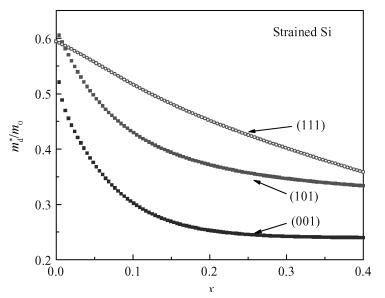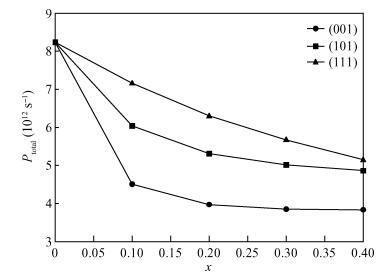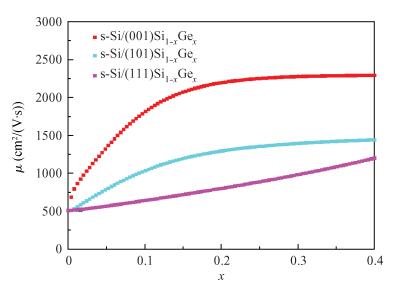| Citation: |
Jianjun Song, He Zhu, Jinyong Yang, Heming Zhang, Rongxi Xuan, Huiyong Hu. Averaged hole mobility model of biaxially strained Si[J]. Journal of Semiconductors, 2013, 34(8): 082003. doi: 10.1088/1674-4926/34/8/082003
****
J J Song, H Zhu, J Y Yang, H M Zhang, R X Xuan, H Y Hu. Averaged hole mobility model of biaxially strained Si[J]. J. Semicond., 2013, 34(8): 082003. doi: 10.1088/1674-4926/34/8/082003.
|
Averaged hole mobility model of biaxially strained Si
DOI: 10.1088/1674-4926/34/8/082003
More Information
-
Abstract
We aim to establish a model of the averaged hole mobility of strained Si grown on (001), (101), and (111) relaxed Si1-xGex substrates. The results obtained from our calculation show that their hole mobility values corresponding to strained Si (001), (101) and (111) increase by at most about three, two and one times, respectively, in comparison with the unstrained Si. The results can provide a valuable reference to the understanding and design of strained Si-based device physics. -
References
[1] Olsen S H, Yan L, Aqaiby R, et al. Strained Si/SiGe MOS technology:improving gate dielectric integrity. Microelectron Eng, 2009, 86(3):218 doi: 10.1016/j.mee.2008.08.001[2] Paul D J. Si/SiGe heterostructures:from material and physics to devices and circuits. Semicond Sci Technol, 2004, 19(10):75 doi: 10.1088/0268-1242/19/10/R02[3] Guillaume T, Mouis M. Calculations of hole mass in-uniaxially strained silicon for the stress-engineering of p-MOS transistors. Solid-State Electron, 2006, 50(4):701 doi: 10.1016/j.sse.2006.03.040[4] Song J J, Zhang H M, Hu H Y, et al. Determination of conduction band edge characteristics of strained Si/Si1-xGex. Chin Phys, 2007, 16:3827 doi: 10.1088/1009-1963/16/12/045[5] Destefanis V, Rouchon D, Hartmann J M, et al. Structural properties of tensily strained Si layers grown on SiGe (100), (110), and (111) virtual substrates. J Appl Phys, 2009, 106:043508 doi: 10.1063/1.3187925[6] Song Jianjun, Yang Chao, Zhang Heming, et al. Longitudinal, transverse, density-of-states, and conductivity masses of electron in (001), (101) and (111) biaxially-strained-Si and strained-Si1-xGex. Science in China, Physics Mechanics and Astronomy, 2012, 55(11):2033 doi: 10.1007/s11433-012-4879-2[7] Song J J, Zhang H M, Hu H Y. Calculation of band structure in (101)-biaxially strained Si. Sci China Ser G-Phys Mech Astron, 2009, 52:546 doi: 10.1007/s11433-009-0078-1[8] Song Jianjun, Zhang Heming, Dai Xianying, et al. Band structure of strained Si/(111) Si1-xGex:a first principles investigation. Acta Physica Sinica, 2008, 57(9):5918 https://ar.scribd.com/doc/210773456/All-Questions-Word-Count[9] Song J J, Zhang H M, Dian X Y, et al. Dispersion relation model of valence band in strained Si. Acta Physica Sinica. 2008, 57(11):7228 http://www.oalib.com/paper/1443499[10] Song Jianjun, Zhang Heming, Hu Huiyong, et al. Valence band structure of strained Si/(111) Si1-xGex. Sci China Ser G:Phys Mech Astron, 2010, 53:454 doi: 10.1007/s11433-010-0093-2[11] Song Jianjun, Zhang Heming, Hu Huiyong, et al. Hole mobility enhancement of Si by rhombohedral strain. Science in China, Physics Mechanics and Astronomy, 2012, 55(8):1399 doi: 10.1007/s11433-012-4755-0[12] Song J J, Zhang H M, Hu H Y, et al. Hole scattering mechanism in tetragonal strained Si. Acta Physica Sinica, 2012, 61(5):057304 http://wulixb.iphy.ac.cn/EN/Y2012/V61/I5/057304 -
Proportional views






 DownLoad:
DownLoad:


















